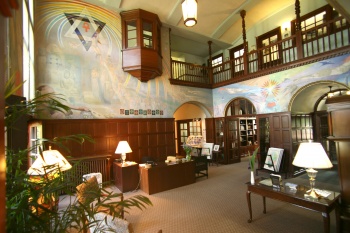Murals at Olcott (art work): Difference between revisions
No edit summary |
|||
| Line 3: | Line 3: | ||
Visitors entering the lobby of the [[L. W. Rogers Building]] at the headquarters of the [[Theosophical Society in America]] are surrounded by a mural painted on all four sides of the lobby. The work was painted in 1931 by Philadelphia artist [[Richard Blossom Farley]]. At the summer convention in 1930, members authorized the mural project that was proposed by arts patron [[Georgine Shillard-Smith|Georgine Wetherill Shillard-Smith]]. Mr. Farley visited the headquarters and measured the space. He returned to his studio in Philadelphia where panels were painted, and then he spent several weeks in the Rogers Building while he applied the canvas panels to the walls. | Visitors entering the lobby of the [[L. W. Rogers Building]] at the headquarters of the [[Theosophical Society in America]] are surrounded by a mural painted on all four sides of the lobby. The work was painted in 1931 by Philadelphia artist [[Richard Blossom Farley]]. At the summer convention in 1930, members authorized the mural project that was proposed by arts patron [[Georgine Shillard-Smith|Georgine Wetherill Shillard-Smith]]. Mr. Farley visited the headquarters and measured the space. He returned to his studio in Philadelphia where panels were painted, and then he spent several weeks in the Rogers Building while he applied the canvas panels to the walls. | ||
Mrs. | Mrs. Shillard-Smith described the intent of the artist as "Life Aspiring Through the Ages": | ||
<blockquote> | <blockquote> | ||
Mr. Farley's ambition is to bring into one focus an impartial suggestion of all life, the past and the avenues that lead to the future, the mysteries that drive the onward multifold manifestations, from the atoms to the suns, the oneness of the endless flowers that bloom and fade on the tree of life, and he believes that the graphic can suggest more than words, for into the million melting tones of color can be woven a fabric too complicated and yet too elemental for words.<ref>Georgine Wetherill Smith, "Life Aspiring through the Ages," World Theosophy 1:9 (September, 1931), 707-708.</ref> | Mr. Farley's ambition is to bring into one focus an impartial suggestion of all life, the past and the avenues that lead to the future, the mysteries that drive the onward multifold manifestations, from the atoms to the suns, the oneness of the endless flowers that bloom and fade on the tree of life, and he believes that the graphic can suggest more than words, for into the million melting tones of color can be woven a fabric too complicated and yet too elemental for words.<ref>Georgine Wetherill Smith, "Life Aspiring through the Ages," World Theosophy 1:9 (September, 1931), 707-708.</ref> | ||
</blockquote> | |||
== Description of murals == | |||
After the first mural was installed on the south wall, Mrs. Shillard-Smith wrote: | |||
<blockquote> | |||
To the left, the figure of Mother Earth receives the evolving forms of life from the water, but looks upward to the Ancient Symbol set in the rays that sweep down over the steps of effort and doubt, by which men rise to achievement. On these steps are the monuments he builds as he aspires. The Christian Celtic Cross, the Buddha, the Sphinx, are plainly portrayed; while pyramid, temple, church, pagoda, and Runic Stones form a background for priest and crusader. All these are dimly seen behind the principal soaring group, of which Pythagoras and Moses form the center figures. To the extreme right, the Group of Heralds over the doorway is as fine a piece of mural work as Puvis de Chevannes's group in the Library of Boston. This south wall represents man's contribution to the great life symphony, and forms the last and greatest picture of the series of wall spaces Farley plans to paint. | |||
The west wall, which is broken into by two arches, is to have as a center the sun and earth, one carrying the sacred fire towards humanity and the other carrying the sword of destruction to the unfit, through the Reptilian Age. Trilobite and Dinosaur, the development of the single cell through the evolution of simple organisms, fishes and mammals, to man. The east wall, between the windows, will be the wall of the planets and stars. Snowflake forms, spores and pollen grains, as well as the Platonic solids, are used to fill up broken spaces, and give a consciousness of the continuity of circumambient life, never a vacuum, always polarities. The reception room is to be decorated with flowers and leaf forms in a narrow frieze.<ref>Georgine Wetherill Smith, 707.</ref> | |||
</blockquote> | </blockquote> | ||
Revision as of 14:34, 5 December 2018
Visitors entering the lobby of the L. W. Rogers Building at the headquarters of the Theosophical Society in America are surrounded by a mural painted on all four sides of the lobby. The work was painted in 1931 by Philadelphia artist Richard Blossom Farley. At the summer convention in 1930, members authorized the mural project that was proposed by arts patron Georgine Wetherill Shillard-Smith. Mr. Farley visited the headquarters and measured the space. He returned to his studio in Philadelphia where panels were painted, and then he spent several weeks in the Rogers Building while he applied the canvas panels to the walls.
Mrs. Shillard-Smith described the intent of the artist as "Life Aspiring Through the Ages":
Mr. Farley's ambition is to bring into one focus an impartial suggestion of all life, the past and the avenues that lead to the future, the mysteries that drive the onward multifold manifestations, from the atoms to the suns, the oneness of the endless flowers that bloom and fade on the tree of life, and he believes that the graphic can suggest more than words, for into the million melting tones of color can be woven a fabric too complicated and yet too elemental for words.[1]
Description of murals
After the first mural was installed on the south wall, Mrs. Shillard-Smith wrote:
To the left, the figure of Mother Earth receives the evolving forms of life from the water, but looks upward to the Ancient Symbol set in the rays that sweep down over the steps of effort and doubt, by which men rise to achievement. On these steps are the monuments he builds as he aspires. The Christian Celtic Cross, the Buddha, the Sphinx, are plainly portrayed; while pyramid, temple, church, pagoda, and Runic Stones form a background for priest and crusader. All these are dimly seen behind the principal soaring group, of which Pythagoras and Moses form the center figures. To the extreme right, the Group of Heralds over the doorway is as fine a piece of mural work as Puvis de Chevannes's group in the Library of Boston. This south wall represents man's contribution to the great life symphony, and forms the last and greatest picture of the series of wall spaces Farley plans to paint.
The west wall, which is broken into by two arches, is to have as a center the sun and earth, one carrying the sacred fire towards humanity and the other carrying the sword of destruction to the unfit, through the Reptilian Age. Trilobite and Dinosaur, the development of the single cell through the evolution of simple organisms, fishes and mammals, to man. The east wall, between the windows, will be the wall of the planets and stars. Snowflake forms, spores and pollen grains, as well as the Platonic solids, are used to fill up broken spaces, and give a consciousness of the continuity of circumambient life, never a vacuum, always polarities. The reception room is to be decorated with flowers and leaf forms in a narrow frieze.[2]








